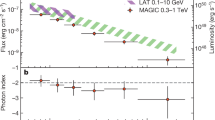Abstract
THE MSSL 2.5–7.5 keV X-ray detector onboard Copernicus1 was pointed in the vicinity of 3U1727—33 for a total of ∼6 h on April 14, 1973 (ref. 2). The 2.5° × 3.5° f.w.h.m. field of view of the detector included the positions of MXB1730—335 (ref. 3), MXB1728—34 (ref. 4) and 3U1727—33 (ref. 5). A new position for 3U1727—33 has been communicated by Saulson and Forman (unpublished). The revised error box is smaller than the one reported in ref. 5 and includes the position of MXB1728—34. The background subtracted count rate observed by Copernicus has been plotted in Fig. 1. Each bin represents one 63-s accumulation followed by 24 s of dead time. The gaps in the data are caused by the occultation by the Earth of the source and passage of the satellite through high background regions. It is clear from Fig. 1 that the flux is modulated throughout with a period of ∼8 min. Using the power spectrum analysis technique described in ref. 6, we find a period of 7.90±0.03 min, with a probability that this could arise from random noise of 10−17 and an average modulation amplitude of 23±5% of the mean flux. Because of the finite sampling time (86.509 s) we cannot exclude the possibility that we are observing an alias of a modulation shorter than the Nyquist frequency of the data. Table 1 gives the first four periods which alias to 7.9 min, along with the expected attenuation for a sinusoidal modulation. The mean flux was ∼2.5 × 10−9 erg cm−2 s−1, at least two to three times greater than that seen from 3U1727—33 by Uhuru5.
This is a preview of subscription content, access via your institution
Access options
Subscribe to this journal
Receive 51 print issues and online access
$199.00 per year
only $3.90 per issue
Buy this article
- Purchase on Springer Link
- Instant access to full article PDF
Prices may be subject to local taxes which are calculated during checkout
Similar content being viewed by others
References
Sanford, P. W., Proc. R. Soc., A390, 411 (1974).
Willmore, A. P., et al. Mon. Not. R. astr. Soc., 169, 7 (1974).
Lewin, W. H. G., et al. Astrophys. J. Lett., 207, L95 (1976).
Hoffman, J. A., et al. Astrophys. J. (in the press).
Giacconi, R., et al. Astrophys. J. Suppl. Ser., 27, 37–64 (1974).
White, N. E., et al. Astrophys. J. Lett., 209, L119 (1976).
Sanford, P. W., and Ives, J. C., Proc. R. Soc. (in the press).
Mason, K. O., Bell-Burnell, S. J., and White, N. E., Nature, 262, 474 (1976).
Markert, T. H., et al. IAU. Circ. No. 2765 (1975).
Ives, J. C., Sanford, P. W., and Bell-Burnell, S. J., Nature, 254, 578 (1975).
Clark, G. W., et al. Astrophys. J. Lett., 207, L105 (1976).
Author information
Authors and Affiliations
Rights and permissions
About this article
Cite this article
WHITE, N., MASON, K., BRANDUARDI, G. et al. Periodic behaviour of the X-ray flux from the region near 3U1727-33. Nature 264, 342–343 (1976). https://doi.org/10.1038/264342a0
Received:
Accepted:
Issue Date:
DOI: https://doi.org/10.1038/264342a0
This article is cited by
-
Coherent oscillations from X-ray burst sources
Astrophysics and Space Science (1982)
Comments
By submitting a comment you agree to abide by our Terms and Community Guidelines. If you find something abusive or that does not comply with our terms or guidelines please flag it as inappropriate.



